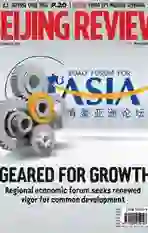Where Are the Big Five Headed?
2014-05-09ByZhouXiaoyan
By+Zhou+Xiaoyan


In China, there is a widely held stereotype concerning major state-owned commercial banks: They never have to sweat or bleed to make money. Instead, they just lie on their back and whistle as torrents of cash flow to them endlessly.
The good old days, however, may be gone. Although the five biggest state-owned banks posted profits as hefty as usual in 2013, they are now cornered by more challenges than ever, coming from a slowing economy, marketoriented reform on interest rates, an increase in bad loans, online investment products and fledging private banks, analysts said.
Slowing profit growth
The Big Five listed stateowned banks—namely the Industrial and Commercial Bank of China (ICBC), China Construction Bank (CBC), Agricultural Bank of China (ABC), Bank of China (BOC) and Bank of Communications (BOCOM)—posted exorbitant profits in 2013.
Together, they pocketed 870 billion yuan($140 billion) in net profits, the equivalent of 2.4 billion yuan ($387 million) a day. Their net profits accounted for over 60 percent of the total of Chinas banking sector.
However, there has been a slowdown in profit growth in all but one of the Big Five. ICBC, the worlds biggest bank in assets, registered 263 billion yuan ($42 billion) in net profits in 2013, up 10.2 percent from 2012. But this growth rate is much lower than the 14.5 percent in 2012. BOCOM saw the sharpest decline in profit growth, from 15.05 percent in 2012 to 6.73 percent in 2013.
A research report from Deloitte predicted that Chinese banks may have entered an era featuring single-digit profit increases.
Guo Tianyong, Director of the Center for Chinese Banking Studies of the Beijing-based Central University of Finance and Economics, said the decline is in line with Chinas economic slowdown.
Chinas economic growth rate declined to 7.7 percent in 2013 from 14.2 percent in 2007. This year, the Chinese Government set the growth target at 7.5 percent. Economic slowdown and rebalancing efforts have reined in the expansion of Chinese banks.
“As a result, the decline in growth rate is quite natural. The two-digital growth rate in previous years is abnormal. In 2014, the growth rate will further slide, even below 10 percent. Eventually, the growth rate will be on a par with GDP growth or a little bit higher than that,” Guo said.
China retains a governmentmandated cap on how much the nations traditional banks are allowed to pay on savings deposits. A gap between that ceiling and lending interest rate is believed to be a major reason for Chinese banks hefty profits. An imminent interest-rate marketization is expected to affect the profitability of the traditionally highly regulated banking sector. Net interest margins are expected to shrink as China moves to phase out the cap on bank deposit rates.endprint
“The final liberalization of deposit rates is the last step of interest-rate marketization,” central bank governor Zhou Xiaochuan said during the annual legislative session in March.
“We are formulating a plan. Its quite likely to be realized within one or two years.”
Luo Yi, an analyst with China Merchants Securities Co. Ltd., said removing the cap on banks deposit rates has a limited impact on their net interest margin.
“In one or two years, when China finalizes interest rate marketization, the overall net interest margin in banks wont significantly decline.
However, the banking sector may see polarized business performances,” Luo said.
Rising bad loans
A slowing economy and the debt overhang from the massive credit-fuelled stimulus that Chinese policymakers launched in response to the 2008 financial crisis are stoking concern about a rise in bad loans.
The overall non-performing loan (NPL) ratio of Chinas banking sector hit a two-year high of 1 percent at the end of 2013, according the China Banking Regulatory Commission.
The newly added NPLs of the Big Five totaled 46.83 billion yuan ($7.6 billion) in 2013, much higher than the 10.95 billion yuan ($1.8 billion) in 2012.
Zong Liang, deputy head of BOCs international finance institute, said the rise in NPLs is inevitable when the country is facing housing market regulation, excess capacity and economic downward pressure.
“However, the industry-wide NPL ratio is within 1 percent, a relatively low level, said Zong. “Banks NPLs are closely connected to the Chinese economy. As long as the economy sees growth, the NPL risk is under control.”
Wang Tao, an economist with UBS Securities, said a great number of trust funds and wealth management products are due to mature within the same period of time. That, combined with a slowing economic growth rate, will bring about redemption crises or even defaults in Chinese banks in years to come.“However, a systematic financial crisis is unlikely to occur,” Wang said in a research note.
The Big Fives annual reports to bourses show that NPL rise mainly appears in certain districts and sectors—areas including the Yangtze River Delta and Pearl River Delta and sectors including retail, wholesale and manufacturing.
Risks also come from local government financing platforms, housing loans and loans to sectors with overcapacity, such as cement and iron.endprint
Qu Hongbin, chief economist with the HSBC, thinks observers shouldnt be overly pessimistic about the quality of Chinas banking assets. “Judging from the array of reform measures China has adopted, China is totally capable of squeezing out the asset bubbles and realizing a soft landing.”
Online challenges
Ever since Yuebao (literally meaning “leftover treasure”), an online investment product provided by Alibaba Group, Chinas e-commerce leader, was launched in June 2013, online investment products have taken off in China, posing a potential threat to traditional banks as more and more spare cash has been transferred to those online financial platforms from traditional banks.
With its attractive yield, better flexibility and fewer restrictions, Yuebao was an instant hit. Many Chinese Internet companies followed suit and developed similar financial services, including search engine giant Baidu, instant messenger developer Tencent and the e-commerce arm of electronics retailer Suning.
The Big Five are on the go to guard their territory. In their annual financial reports, challenges from online financial products were frequently mentioned, as well as their overall business layout to take on those challenges.
As a defense, they lowered their daily ceiling of money that can be transferred from their bank accounts to those online investment platforms. They also proactively developed their online business products, such as e-bank, banking service apps for mobile phones and banking services via WeChat, a mobile text and voice messaging app developed by Tencent. Theyve also released similar products to Yuebao.
For instance, as of the end of 2013, the ICBC had 160 million e-banking service users, over 130 million mobile banking app users and 80 percent of transactions are conducted online.
Hou Weidong, Vice President of BOCOM, said Internet companies push into the financial service sector could be complementary to traditional banks services, although they may pose a potential threat to traditional institutions.
“Internet companies have the gene of innovation, which creates new impetus for traditional commercial banks to innovate and to reflect on their traditional business models. Facing pressure, traditional banks will actively innovate and play up their advantages.”
Hou argues traditional banks still boast many advantages that Internet companies fall short of.
“We have a complete risk management system, which is helpful for stabilizing the online financial market. Also, after decades of online business development, banks have accumulated a number of talented people that are both familiar with finance and Internet applications. These are the advantages that non-financial institutions can hardly achieve in a short period of time.”endprint
